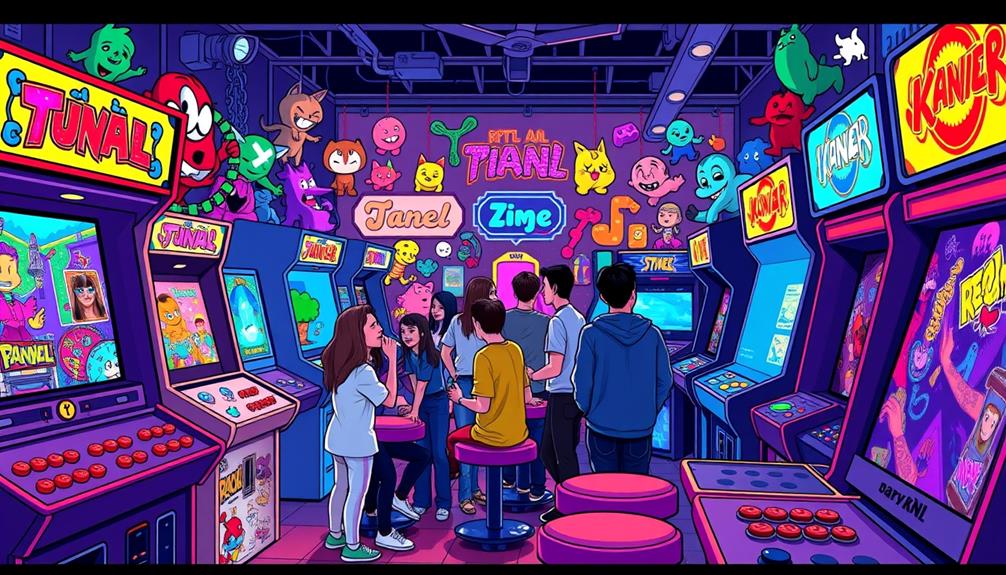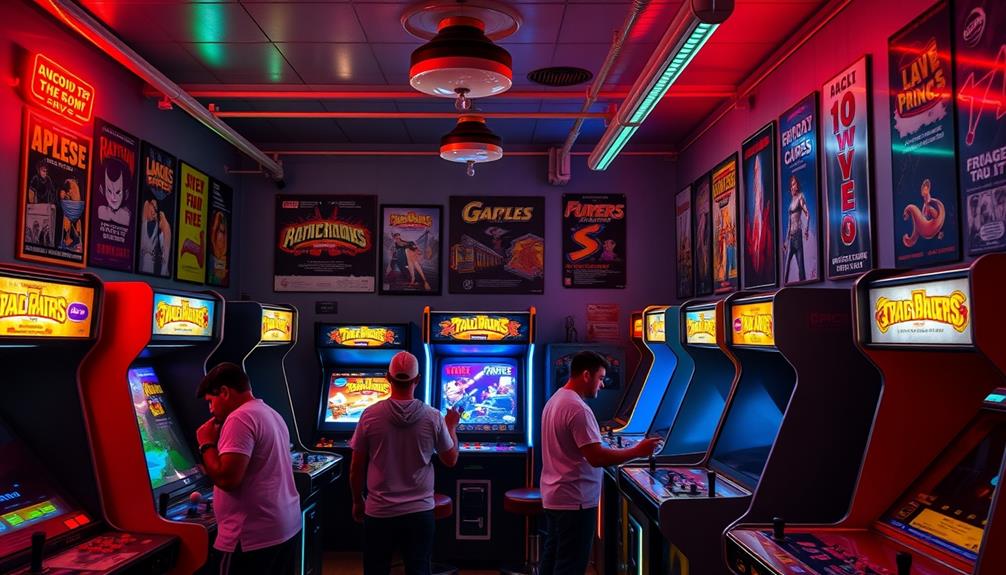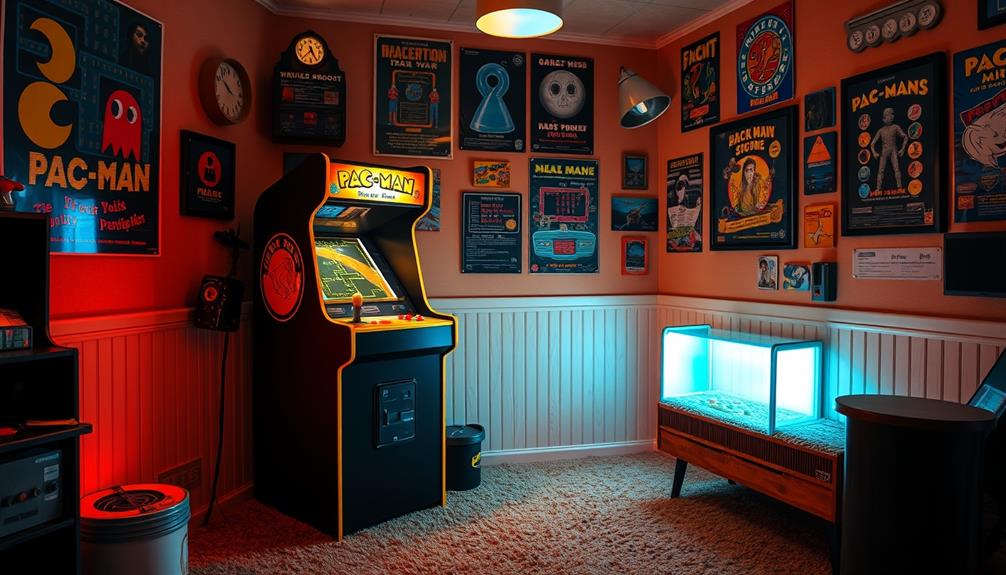Arcade games are enjoyable, coin-operated machines that are typically found in public spaces and offer a variety of gaming experiences. These games can range from video games to pinball machines and even skill-based challenges like Skee-Ball. They became extremely popular during the late 1970s and 1980s, introducing iconic titles such as Pac-Man and Space Invaders. While arcade games mainly emphasize skill, you may also encounter chance-based games like slot machines. As technology has advanced, so too have these games, incorporating advanced graphics and even virtual reality elements. If you are interested in learning more about their fascinating history and the latest trends, there is plenty more to discover.
Key Takeaways
- Arcade games are coin-operated machines typically found in public spaces, offering various gaming experiences like video games, pinball, and skill-based games.
- The golden age of arcade games occurred in the late 1970s to 1980s, featuring iconic titles like Pac-Man and Space Invaders.
- Arcade games encompass multiple genres, including skill-based, redemption, chance-based, video games, driving games, and fighting games.
- Technological advancements, such as 3D graphics and VR integration, have significantly enhanced arcade gaming experiences over the years.
- Arcade games foster social interaction and community engagement, creating vibrant spaces for players to connect and compete.
Definition of Arcade Games
Arcade games are coin-operated machines that you typically find in public spaces, offering a variety of gaming experiences, from video games to pinball and electro-mechanical games.
These arcade machines provide an exciting way to engage with friends and strangers alike while testing your skills on short, challenging levels. The golden age of arcade games, which spanned from the late 1970s to the 1980s, marked a peak in their popularity, turning amusement arcades into cultural hubs where players could gather for fun and competition.
Many arcade enthusiasts now explore options for their home game rooms, seeking out machines that blend classic designs with modern technology integration, like those in the best arcade machines for home game rooms.
Each game typically features simple and intuitive controls, making it easy for anyone to jump in and play. You effectively "rent" your game time based on how long your character survives, which keeps you coming back for more.
The high difficulty levels not only enhance the challenge but also guarantee profitability for arcade owners. Although the rise of home and portable gaming has led to a decline in traditional arcade games, many enthusiasts still feel nostalgic about the experience.
The thrill of inserting a coin and diving into a vibrant world of fun remains a cherished memory for many players.
Types of Arcade Games

When you step into an arcade, you'll find a variety of game types that cater to different interests. Among these, pinball machines stand out with their unique combination of mechanical and electronic components, offering a dynamic gameplay experience.
Skill-based arcade games challenge your abilities, while redemption game mechanics offer the thrill of earning tickets for prizes.
Plus, the evolution of pinball machines continues to captivate players with modern twists on a classic favorite, reflecting their rich history in the gaming world, including the first true pinball machine.
Skill-Based Arcade Games
At the heart of the arcade experience, skill-based games challenge players to hone their reflexes and strategic thinking. Unlike chance-based games, these skill-based arcade games require you to engage actively, aiming for high scores or completing levels. A classic example is pinball machines, where you aim to hit targets and keep the ball in play for as long as possible.
The charm and allure of these games can be likened to the way different zodiac signs influence personality traits and attractiveness, enhancing the overall experience of gaming astrological signs and perceived beauty.
During the Golden Age of Arcade Games in the late 1970s and early 1980s, titles like Pac-Man and Space Invaders became iconic, emphasizing player skill and competition. These games captured your attention and pushed you to improve with each attempt.
Technological advancements have also played a significant role in the evolution of skill-based arcade games. The introduction of microprocessors and 3D graphics added layers of complexity and appeal, ensuring these games remain relevant even in today's competitive gaming landscape.
While redemption games like Skee-Ball incorporate an element of chance by rewarding tickets based on performance, skill-based arcade games focus on your ability to control outcomes through skill and practice.
Redemption Game Mechanics
Redemption games create an engaging atmosphere where players can earn tickets or points based on their performance, adding an exciting layer to your arcade experience. These games, like "Skee-Ball" and "Whack-a-Mole," utilize skill-based video games to reward you for honing your abilities. This not only enhances your player engagement but also makes each visit to the arcade more memorable.
Here's a quick overview of some popular redemption games:
| Game Type | Mechanics | Prize Potential |
|---|---|---|
| Skee-Ball | Roll balls into scoring holes | Varies by tickets earned |
| Whack-a-Mole | Hit moles with a mallet | Accumulate tickets |
| Basketball Toss | Score points by shooting | Larger prizes available |
Ticket redemption systems create a sense of accomplishment, encouraging you to return for more fun. With modern technology, these games feature interactive elements that enhance your experience. The thrill of collecting tickets adds an irresistible charm to arcades, making redemption games a must-try for everyone. So, gear up for some friendly competition and see how many tickets you can earn!
Evolution of Pinball Machines
Arcade games have evolved considerably over the decades, and one of the most fascinating examples is pinball machines. These machines have undergone a significant alteration since their introduction in 1933. Initially, they lacked flippers, classifying them as games of chance. However, the electric flipper's introduction in 1947 shifted the gameplay to skill-based.
Today, pinball machines are celebrated for their advanced technology and design, such as those seen in the best rated pinball machines of 2024, showcasing both classic and modern innovations.
Here's a quick look at the evolution of pinball machines:
- Electro-Mechanical Games: In the mid-20th century, machines progressed from purely mechanical designs to electro-mechanical games, enhancing gameplay with lights, sounds, and complex scoring systems.
- Solid-State Electronics: The 1970s brought solid-state electronics, allowing for intricate designs and features that paved the way for modern pinball machines.
- Golden Age of Arcade Games: The late 1970s and early 1980s saw a surge in popularity, with iconic titles like "The Addams Family" becoming some of the highest-grossing machines in history.
Despite challenges from video games in the 1990s, pinball machines are experiencing a resurgence today. New manufacturers are combining traditional gameplay with modern technology, keeping this classic arcade game alive and well.
Skill vs. Chance Games

Many players find themselves drawn to the excitement of skill vs. chance games in the arcade. These games fall into two main categories: skill-based games, where your ability impacts the outcome, and games of chance, primarily determined by luck. Understanding the differences can enhance your gaming experience.
| Skill-Based Games | Games of Chance |
|---|---|
| Player skill influences outcome | Results rely on luck |
| Examples: pinball, skee-ball | Examples: slot machines |
| Often involves strategy | Typically monetary prizes |
| Redemption games blend both | Stricter regulatory status |
Redemption games, a popular subcategory, reward you with tickets based on your performance, allowing you to exchange them for prizes. Notably, the regulatory status of these arcade games often hinges on the skill versus chance distinction. For instance, while pinball machines were once considered games of chance, the introduction of the electric flipper shifted their classification to skill-based, impacting their availability.
Historical Evolution

Throughout the years, the evolution of arcade games has captured the imagination of players and enthusiasts alike. You might be surprised to learn how this journey began and transformed into what's understood today.
As the industry matured, high-quality content related to arcade gaming began to emerge, enhancing player engagement and community interaction.
Here are three key milestones in this historical evolution:
- 19th Century Origins: Arcade games started in amusement parks with skill-based attractions, paving the way for coin-operated machines.
- First Commercial Arcade: In 1971, Atari released "Computer Space," the first commercial arcade video game, inspired by "Spacewar!" from 1962, marking a significant shift in gaming.
- Golden Age: The late 1970s and early 1980s ushered in the Golden Age of arcade games. Iconic titles like "Space Invaders" and "Pac-Man" captured the hearts of players, solidifying arcade gaming's cultural significance.
As the popularity of home gaming consoles grew in the late 1980s, arcades faced challenges. They adapted by transforming into Family Entertainment Centers, focusing on nostalgia-driven experiences that appealed to adult audiences.
This evolution showcases the resilience and creativity of the arcade gaming industry, ensuring its place in both gaming history and culture.
Technological Advancements
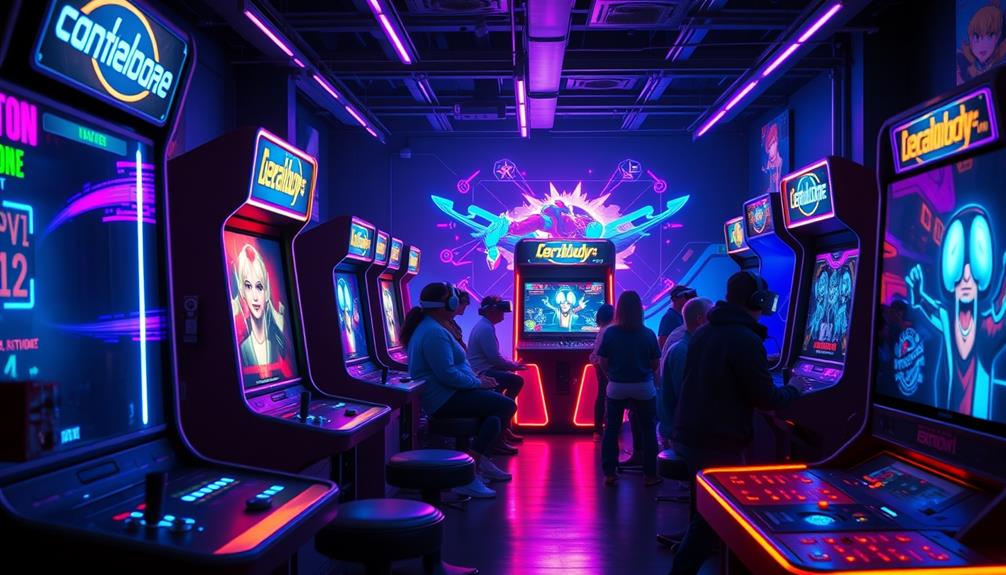
You've probably noticed how arcade games have transformed over the years, especially in game mechanics and graphics.
With the introduction of 3D technology and VR experiences, the way you interact with games has reached new heights.
These advancements in technology are akin to how AI discovers cures for diseases, pushing the boundaries of what's possible in gaming.
Let's explore these technological advancements and how they've reshaped your gaming experience.
Evolution of Game Mechanics
The evolution of game mechanics in arcade games has been markedly shaped by technological advancements over the decades. In the mid-1970s, the introduction of programmable microprocessors allowed for more complex gameplay, starting with competitive titles like "Gun Fight."
During the golden age of arcade games from 1978 to 1982, iconic games like "Space Invaders" and "Pac-Man" emerged, featuring innovative scoring systems that heightened player engagement. The integration of innovative coffee gear has similarly transformed the brewing experience for coffee enthusiasts, showcasing how advancements in technology can enhance enjoyment in different domains.
Here are three key developments that defined this evolution:
- Complex Gameplay: The shift toward more intricate game mechanics offered players deeper experiences and longer play sessions.
- Control Schemes: Innovations such as dual-joystick controls in "Defender" and the six-button setup in "Street Fighter II" revolutionized how you interact with games.
- 3D Graphics & VR: The early 1990s saw a technological renaissance with 3D titles like "Virtua Racing," transforming gameplay dynamics and immersing players in virtual worlds.
These advancements have continually shaped the landscape of arcade games, ensuring that you experience an ever-evolving array of game mechanics that keep you coming back for more.
Impact of Graphics
Graphics play a pivotal role in shaping your arcade experience, greatly influencing how you interact with games. The introduction of 3D graphics in the early 1990s marked a notable turning point in arcade gaming, bringing more immersive and visually engaging experiences. Titles like Virtua Racing and Virtua Fighter showcased how this technology allowed developers to create complex game mechanics and environments, enhancing your enjoyment and engagement.
These advancements mirror the uplifting essence found in songs like Blue Skies and Lemonade, which evoke feelings of joy and nostalgia, much like the engagement brought by enhanced visuals in gaming.
Advanced arcade systems, such as Sega Model 3, leveraged cutting-edge graphics technology to outperform home consoles until the late 1990s. This demonstrated that stunning visuals can greatly impact player engagement.
Furthermore, the rise of motion simulation and virtual reality arcade games reflects ongoing advancements in graphics technology, offering experiences that replicate real-world scenarios.
Continuous innovation in high-definition displays and realistic animations keeps arcade games relevant and appealing to new generations. As graphics technology evolves, it not only enhances the aesthetic appeal but also deepens your connection to the games you play.
Ultimately, the impact of graphics in arcade games is undeniable, making your gaming experience more immersive and exciting than ever before.
VR Integration Trends
As arcade gaming evolves, VR integration is taking center stage, transforming how you experience virtual worlds.
With advanced technology, arcades are offering immersive gaming experiences that draw you into engaging environments like never before. AI-Powered Virtual Reality in E-Learning exemplifies how immersive technologies enhance interaction and engagement.
Here are some trends you can expect:
- Enhanced Immersion: VR technology allows you to plunge into realistic simulations, from roller coasters to thrilling adventure quests.
- Multiplayer VR Setups: Experiences like Hologate and Omni Arena promote teamwork and social interaction, making your gaming sessions more exciting and memorable.
- Physical Engagement: VR arcade games deliver unique physical experiences, combining motion simulation with gameplay that heightens realism and excitement.
The increasing demand for VR experiences has led arcade operators to invest heavily in creating themed environments that attract a diverse audience.
This shift not only differentiates arcades from home gaming systems but also encourages repeat visits.
As you explore these VR integration trends, you'll discover a new level of fun and excitement that keeps you coming back for more.
Embrace the future of arcade gaming, where every visit promises an unforgettable adventure!
Cultural Impact

How did arcade games become such an important part of our culture? In the late 1970s and 1980s, they emerged as a cultural phenomenon, transforming social interactions and creating vibrant community spaces. Iconic titles like Pac-Man and Space Invaders not only shaped gaming culture but influenced fashion, music, and entertainment. This impact extended into mainstream media.
The arcade scene also played a significant role in the rise of competitive gaming, fostering tournaments that brought players together, creating bonds and camaraderie. In Japan, arcade gaming remained significant until the late 2010s, with a notable decline in venues reflecting shifting gaming preferences.
However, the COVID-19 pandemic dealt a severe blow to the arcade industry, leading to the closure of many beloved establishments. This change highlights the evolving landscape of social gaming experiences.
| Aspect | Impact |
|---|---|
| Community Spaces | Fostered social interactions |
| Competitive Gaming | Rise of tournaments |
| Cultural Influence | Impact on fashion and music |
| Decline in Arcades | Shift in gaming preferences |
Arcade games have left an indelible mark on our culture, creating connections that transcend generations.
Popular Arcade Genres

Arcade games have evolved into a diverse array of genres that cater to different interests and gaming styles. Whether you're looking for competition, skill, or just pure fun, there's something for everyone in the arcade.
New England's scenic beauty and outdoor activities draw parallels to the excitement of arcade gaming, where the thrill of competition and skill can be found in various forms, such as popular camping activities.
Here are three popular genres you'll encounter:
- Video Games: Featuring classics like Pac-Man and Space Invaders, these games focus on competition and enjoyment, often becoming the heart of any arcade.
- Redemption Games: Games like Skee-Ball and Stop the Wheel reward your performance with tickets, which you can exchange for exciting prizes, adding an element of thrill.
- Fighting Games: Titles like Street Fighter II fuel competitive play and community engagement, making them a staple in arcade culture.
Other popular genres include pinball machines, which have transformed from simple designs to complex electronic systems, and merchandiser games like claw machines that dispense prizes directly.
Each genre offers a unique experience, encouraging you to explore and try your hand at various games.
Customer Engagement Strategies

Customer engagement strategies are essential for fostering a vibrant arcade atmosphere. To enhance customer retention, consider implementing loyalty programs that reward players with points or discounts based on their gameplay frequency. This encourages them to return and engage more often.
Hosting special events and tournaments can also create excitement and encourage social interaction among players. These events not only increase foot traffic but also cultivate a sense of community within your arcade.
Regularly updating your game lineup with new titles keeps the experience fresh and motivates customers to visit frequently.
Don't underestimate the power of social media. Engaging with your customers through platforms like Facebook and Instagram allows for direct communication and feedback. This fosters a sense of belonging, enhancing customer loyalty.
Industry Trends
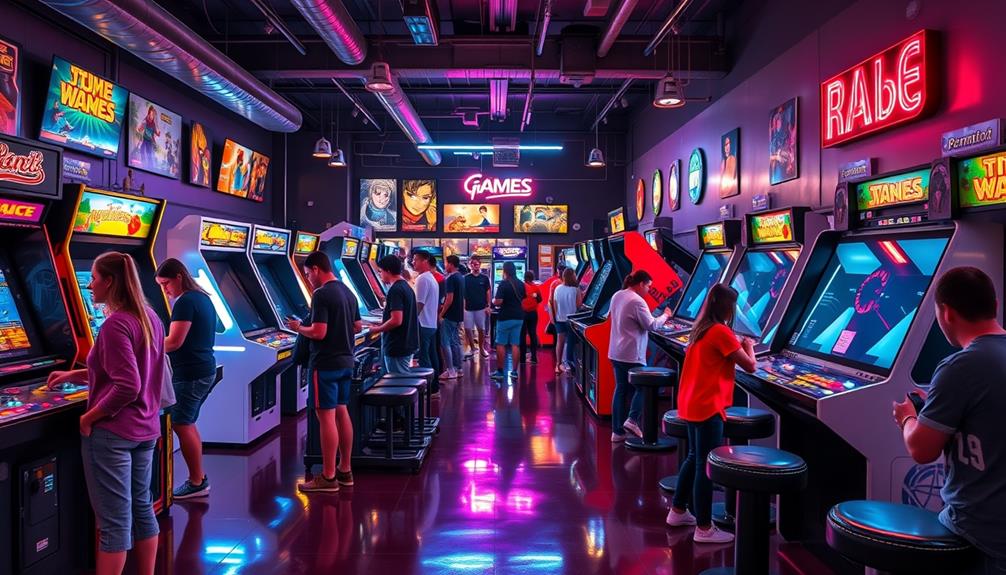
Innovation drives the arcade industry forward, with several key trends reshaping the landscape. As you explore the latest developments, you'll notice that technology and player preferences are evolving rapidly.
Here are three significant trends to watch:
- Virtual Reality: The adoption of VR technology is skyrocketing, with multiplayer experiences becoming increasingly popular among players. This immersive gaming environment enhances the traditional arcade experience, drawing in crowds enthusiastic for something new.
- Mobile Gaming Integration: The blending of mobile gaming with arcade platforms is transforming gameplay. You'll find that many arcades now offer games that shift seamlessly from phone to arcade, making it easier for you to engage with your favorite titles.
- Esports Rise: The explosion of esports has created a competitive gaming phenomenon, attracting large audiences and inspiring arcade-style play. This trend not only boosts foot traffic but also fosters a sense of community among players.
These trends highlight the arcade industry's commitment to continuous innovation, ensuring that customer engagement remains strong in an increasingly competitive entertainment landscape.
Future of Arcade Games

As you think about the future of arcade games, consider how emerging technologies like virtual reality are reshaping player experiences.
The influence of e-sports is also driving growth, making competitive gaming a staple in many arcades.
Plus, the nostalgia for retro games is sparking a revival, creating spaces where you can enjoy classic titles alongside modern innovations.
Emerging Technologies Integration
Emerging technologies are transforming the future of arcade games, creating experiences that are more immersive and engaging than ever before. As you explore these developments, you'll notice three key trends shaping the landscape:
- Virtual Reality (VR): With options like Hologate and Omni Arena, VR enhances multiplayer experiences, letting you interact with friends in thrilling, immersive environments.
- Augmented Reality (AR): AR gaming is making waves in arcades, allowing you to engage with digital elements overlaid on your surroundings, adding a layer of excitement and novelty to traditional gameplay.
- Mobile Gaming Integration: The rise of mobile gaming influences arcade design, encouraging features like app access for games and loyalty rewards. This attracts a younger demographic, making the arcade more appealing.
Additionally, e-sports tournaments are becoming a staple in arcade venues, merging traditional gameplay with competitive gaming. This not only draws larger audiences but also revitalizes interest in the arcade culture.
As these emerging technologies continue to integrate, you can expect an incredibly engaging future for arcade games, filled with opportunities for social interaction and novel experiences.
E-Sports Influence Growth
The rise of e-sports is reshaping the arcade landscape, blending competitive gaming with traditional arcade experiences. You'll notice that modern arcades are increasingly integrating e-sports tournaments and leagues, creating platforms for players to compete in popular titles like Street Fighter and Tekken. This mirrors the atmosphere of traditional sports arenas, drawing in large audiences and boosting interest in arcade games.
As e-sports continues to gain traction, arcade developers are enhancing gameplay mechanics to cater to both casual players and serious competitors. With events like the 2021 League of Legends World Championship attracting over 4 million concurrent viewers, the potential for arcades to tap into this booming market is undeniable.
Operators are also collaborating with e-sports organizations to create hybrid entertainment venues. These spaces combine classic arcade games with e-sports competitions, appealing to a broader audience and elevating the arcade experience.
In this evolving landscape, you can expect to see a fusion of gaming styles that not only celebrates nostalgia but also paves the way for the future of arcade gaming. E-sports isn't just an influence; it's a catalyst for growth in the arcade sector.
Nostalgia and Retro Revival
Nostalgia for classic arcade games is driving a remarkable revival in the gaming scene, bringing together players of all ages in search of that retro experience. This resurgence isn't just about playing old games; it's a cultural phenomenon, reflecting a deep appreciation for the past.
Here are three key aspects of this revival:
- Barcades: These venues blend traditional arcade gaming with a social atmosphere, offering drinks and a place to gather, which appeals to adults longing for that nostalgic vibe.
- Retro-themed events: Tournaments celebrating iconic titles like Pac-Man and Street Fighter II are booming, attracting both older generations and younger players keen to plunge into vintage gaming culture.
- Arcade preservation groups: These community-driven initiatives focus on maintaining and restoring classic arcade games, ensuring their relevance in today's gaming landscape.
As the gaming industry embraces nostalgia, operators are creating a hybrid experience by incorporating retro machines alongside modern titles.
With the market for retro arcade games on the rise and new releases reflecting this trend, it's clear that the love for classic arcade games is here to stay.
Frequently Asked Questions
What Defines an Arcade Game?
An arcade game's defined by its coin-operated mechanics, quick gameplay, and escalating challenges. You engage with simple controls, aiming for high scores or rewards, while enjoying a social atmosphere that fuels competition and excitement. From classic games like Pac-Man and Space Invaders to modern favorites like Dance Dance Revolution and Time Crisis, arcade games offer a wide range of experiences for players to enjoy. Whether you’re trying to beat your own personal best or challenge a friend to a high-stakes match, the adrenaline rush of playing in an arcade is unmatched. So if you’re looking to experience the storm of excitement and competition, head to your nearest arcade and let the games begin!
Why Are They Called Arcade Games?
Like a treasure hunt, you pay to play arcade games, seeking high scores and moments of joy. They're called arcade games because they originated in amusement arcades, where coin-operated machines brought together players for fun and competition.
How Do Arcade Games Work?
Arcade games operate by you inserting coins or tokens to play. They challenge your skills with progressively harder levels, often rewarding your efforts with tickets for prizes, blending chance and skill for a thrilling experience.
What Is the Difference Between an Arcade Game and a Video Game?
Did you know 90% of arcade players seek high scores? Arcade games focus on quick, skill-based competition in social settings, while video games often emphasize storytelling and longer, immersive gameplay on various platforms without coin requirements.
Conclusion
In the world of arcade games, nostalgia meets innovation. While classic pixelated adventures evoke fond memories, cutting-edge technology promises immersive experiences. You can relish the thrill of skill-based challenges or the luck of chance games, each offering unique excitement. As the industry evolves, it's clear that the joy of gaming will always bridge generations. So whether you're revisiting retro titles or diving into virtual reality, the heart of arcade gaming remains the same: fun and connection.


